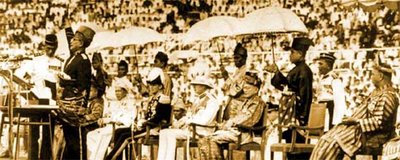Exploring independence' s image-reality gaps

 (Updated) The official photograph above is supposed to clearly show that Peninsular Malaya had achieved Merdeka from Britain on 31 August 1957. However, behind the symbolic image, the political reality was not so clear as, from 1958 to 1966, the IGP of 'independent' Malaya was still a London-born colonial policeman, Claude Fenner (left).
(Updated) The official photograph above is supposed to clearly show that Peninsular Malaya had achieved Merdeka from Britain on 31 August 1957. However, behind the symbolic image, the political reality was not so clear as, from 1958 to 1966, the IGP of 'independent' Malaya was still a London-born colonial policeman, Claude Fenner (left).Moreover, even after 31 August, 1957, British as well as other foreign troops and mercenaries continued to station and operate on a large scale inside a supposedly independent nation under the 1957 Anglo-Malayan/Malaysian Defence Agreement (AMDA) until 1984.
 Sitiawan-born Chin Peng remembers that in the 1955 Baling Peace Talk, the Communist Party of Malaya (CPM) offered to "stop the (anti-colonial) war immediately" as soon as the governments of Malaya and Singapore "have self-determination in internal security and national defence matters". (see Alias Chin Peng: My Side of History, Singapore, Media Masters; p.384)
Sitiawan-born Chin Peng remembers that in the 1955 Baling Peace Talk, the Communist Party of Malaya (CPM) offered to "stop the (anti-colonial) war immediately" as soon as the governments of Malaya and Singapore "have self-determination in internal security and national defence matters". (see Alias Chin Peng: My Side of History, Singapore, Media Masters; p.384) So, Singapore-born veteran journalist Said Zahari once recalled : "In 1957, I became a witness to history again when I saw the Union Jack being lowered in Kuala Lumpur, but at that time, I also quietly wondered if that was the end of colonialism or the beginning of neo-colonialism". In kaki-lima parlance, that not-so-heroic state of affairs was called merdeka setengah masak.
So, Singapore-born veteran journalist Said Zahari once recalled : "In 1957, I became a witness to history again when I saw the Union Jack being lowered in Kuala Lumpur, but at that time, I also quietly wondered if that was the end of colonialism or the beginning of neo-colonialism". In kaki-lima parlance, that not-so-heroic state of affairs was called merdeka setengah masak.PAS: Communist party helped secure Merdeka
Said Zahari: read Chin Peng’s memoirs with open mind
Foreign troops on our soil: the true history
Tunku Abdul Rahman — the pro-West ‘nationalist’
Opposition to Tunku’s pro-West foreign policies


2 Comments:
James,
Rakyat Malaysia seharusnya diingatkan bahawa hari kebangsaan yang sebenarnya islah pada 16 September1963.
31 Ogos 1957 ialah hari Malaya merdeka. Malaysia dibentuk pada 16 September 1963.
Macam mana tahun ini kerajaan Malaysia boleh menyambut Hari Kemerdekaan negara di Sarawak? Sedangkan pada 31 Ogos 1957, Sarawak masih lagi belum bersama Malaysia.
Apakah kita nak biarkan rakyat Malaysia terus diperbodohkan oleh Barisan Nasional?
Uncle James,
I remembered vividly how much I hate history written in my secondary school's text book (thank goodness I failed). However as I grew older, I started to reconstruct my own version of Malaysia history, from scratch. Your blog serves as a good reference, but one post a day is tak cukup makan.
Mr Black, saya lihat Malaysia tidak mencapai kemerdekaan sehingga 1984. Dalam tafsiran saya, Malaysia tidak merdeka selagi tentera asing masih aktif di tanah air ku. Macam mana kita nak kata tahun sebelum 1984 Malaysia sudah merdeka, sedangkan kita tak ada sovereignty..
Post a Comment
<< Home